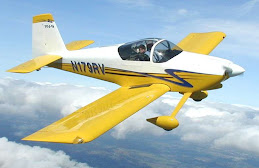Riveted platenuts to bottom flange of left wing spar. Found major manufacturing fault. Contacted Vans.
I went back to work on the wing spar this evening and completed riveting all the platenuts on the bottom flange of the left spar, including the #6 platenuts for the three inspection plates.
When you have got a lot of anything to do, I find it better to break it down into its parts and approach it production-line style. For example on this job, rather than making a separate job of each platenut, I did all of them together following these steps:
- Cleco one 'lug' of every platenut in place.
- Put rivets in the other lug of every platenut.
- Squeeze all of these rivets.
- Replace the clecos with rivets in the 2nd lug of each platenut and
- Squeeze these rivets.
 When I turned the spar around to begin the platenuts on the top flange, I happened to sight down along the flange and noticed immediately that it was not square to the web. The picture shows my set-square held with its blade along the outside of the web and you can clearly see the gap under the corner of the 'stock'. My protractor showed that it was, in fact, 6 degrees underbent (96 degrees between web and flange). I checked the other spar, which was still in its polythene and it is precisely the same. I offered up a rib to the spar in case it was meant to be like this and found that the flange should, in fact, be about the same amount off vertical in the other direction if it is to match the slope of the rib top flange at this point. There is a gap of about 10 to 12 degrees between the two parts. Clearly, a wing can't be built on the basis of these spars in this condition.
When I turned the spar around to begin the platenuts on the top flange, I happened to sight down along the flange and noticed immediately that it was not square to the web. The picture shows my set-square held with its blade along the outside of the web and you can clearly see the gap under the corner of the 'stock'. My protractor showed that it was, in fact, 6 degrees underbent (96 degrees between web and flange). I checked the other spar, which was still in its polythene and it is precisely the same. I offered up a rib to the spar in case it was meant to be like this and found that the flange should, in fact, be about the same amount off vertical in the other direction if it is to match the slope of the rib top flange at this point. There is a gap of about 10 to 12 degrees between the two parts. Clearly, a wing can't be built on the basis of these spars in this condition.I remembered an article on page 10 of the latest RVator, telling the story of Terry Elgood, a Canadian builder who had the same problem. Terry fixed his spars by cutting a notch in the end of a length of oak and bending the flange back to its proper position by using putting the notch over the flange and levering it, little by little, working up and down along the length of the spar moving only an inch or less at a time.
I am deeply suspicious of this. I can't see how you can get a straight flange out of this procedure as the lever is exerting a point load on a very short section of flange at a time. In fact I think I see some waves in the lip of Terry's flange in the photos but the resolution is not high enough to be sure. I remembered thinking how convenient for Vans if builders, especially those at a great distance from Aurora, would be so good as to fix Vans quality problems and save them from shipping expensive replacement parts to the four corners of the globe.
Before hysteria took over, I rang Vans support and Ken answered. He was sympathetic of course and embarrased that it had happened but basically he is happy that Terry Elgood's method makes the issue go away and its up to me to implement it. To be fair, he said they would "make it right" whatever that means. However, I couldn't make him say that he would replace the spars if the repair went wrong. I have to think about this some more.
NOT a good day!


No comments:
Post a Comment